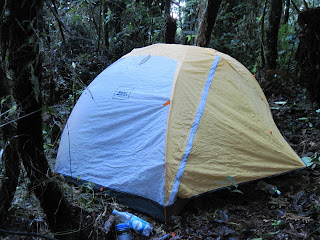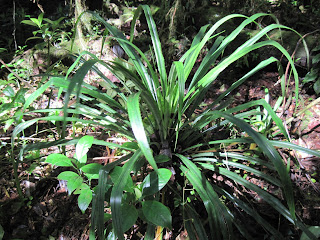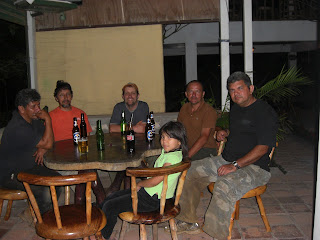Waking up and climbing out of the tent in the old growth cloud forest of the Parque Nacional Montana de Comayagua, I found myself instantly shivering. It was just light out, and we had camped about 100m from the top of one of the high points in the mountains just east of the central Honduran city of Comayagua. We had hiked in t-shirts the previous afternoon, climbing on a ridge from the coffee growing community of Las Moras at 1400 meters above sea level, to the last farmhouse at 1650 meters, to the beginning of the old growth cloud forest at about 1900 meters, to our campsite, just shy of 2300 meters (about 7000 feet). The hike was relatively short (about 4 hours), but strenuous - almost all uphill. As the evening came on, the wind had picked up, and by morning I'd wager that the temperature was somewhere in the 40's or 50's. I put on my two wool shirts and my raincoat and both pairs of pants and started to hop around. I had slept fine in my sleeping bag with my thermarest, but others in my group had not fared so well. Hector had found a root underneath him. Hernan's tent had let rain in. Victor and Disne were chilled.Luis didn't complain. But this was an adventure and no one seemed to have lost any enthusiasm for the trip.
After a warm breakfast of oatmeal, the sun was already much warmer, and Luis, Hector and I left the campsite to try to make the summit. I was surprised how close we were to the top (we had just run out of light the previous evening and had stopped to camp about 15 minutes from the very top). However, I was glad we hadn't camped on the summit, because the winds were much higher up there. When we got there, I was also glad to recognize the place from our trip two years ago, and we spent some time looking for Bayron's missing camera - to no avail. On the way back to the campsite, we briefly missed the path. There was a moment of uncertainty - at the top of the mountain the ridges level out into a relatively flat area, so it was not as easy to find one's way as it was on the ridge that we climbed the day before. But we used landmarks and consensus to decide where to turn and eventually we could holler back and forth to Hernan at the campsite.
I think there is something magical about a visit to any old growth forest. To be in a place that is essentially untouched by the 10,000 plus years of human habitation in Central America is to be somehow closer to the source. There are massive trees standing. Others fallen, with smaller trees filling the gaps. The trees are covered with plant life - epiphytic plants that create their own ecosystems on top of the branches and on the trunks. There are mosses, bromeliads, orchids, ferns, vines, and more. The soil the forms on the ground and on the tree branches is spongy with organic matter. For me, to visit a cloud forest is like a pilgrimage to a holy place. It is important to know that the rich ecosystem of the cloud forest is also vital to the capture and regulation of precipitation into the water table. Without the vegetation to stop the rain and cause it to sink into the ground, the rainy season would have terrible floods and the dry season would have incredible droughts. Also the massive forest transpires millions of gallons of water into the air and keeps the area around the mountain cool and moist. Without the forest, the climate of the whole mountain and valley system would be hotter and drier.
.jpg)
.jpg)
 |
| Bromeliad right next to my tent. |
 |
| Victor and Hector - chilled in their tent. |
 |
| My little REI special. Dry. |
 |
| Hernan - trying to stave off the cold. |
 |
| left to right: Luis, Andres, Victor, Hector, Hernan (Disne took the photo) |
 |
| Tree fern. |
 |
| Looking up at a tree near the top of the mountain. |
 |
| Tree trunk covered with vines and plants. |
 |
| Avocado seed from a wild avocado (preferred food of the quetzal) |
 |
| Moss. |
 |
| Breomeliad - much like a pineapple plant. |
 |
| Wild chicken-like bird feathers that Luis found near the summit. |
 |
| Massive tree. |
 |
| Wild avocado - very little meat - mostly seed. |
 |
| Bromeliads. |
 |
| This is my old camping stove, that Hernan kept from 18 years ago. Still works! |
 |
| Tree fern. |
 |
| Hector is leaning against a massive fallen tree. I asked him to stand in the photo for perspective. |
 |
| Bromeliads |
 |
| Looking back at the ridge, it doesn't seem like that far of a hike. We hiked from the extreme left side of the photo up to the point that is about 1/3 of the way from the left hand side. |
 |
| Looking down to the Comayagua valley. |
 |
| Loading the gear. |
 |
| Victor and Disne |
 |
| Andy and Hernan |
 |
| The much appreciated cerveza after returning to Comayagua. |
.jpg)
.jpg)